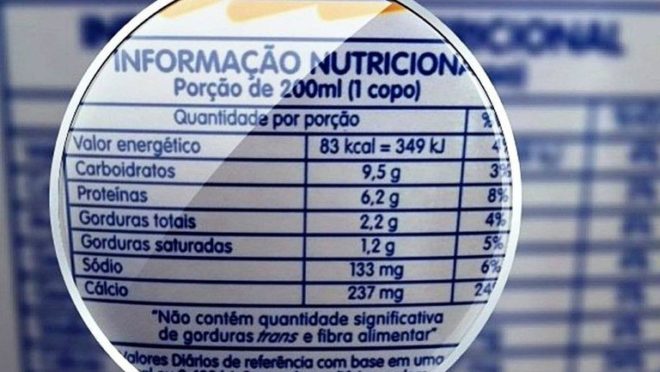In Brazil, nutritional labeling emerged in the 1980s and is now mandatory. Nutritional labeling aims to facilitate communication between consumers and brands. The body responsible for regulating the labeling of packaged foods in Brazil is the National Health Surveillance Agency (ANVISA), Ministry of Health, Ministry of Agriculture and Livestock and Supply (MAPA) and the Institute of Metrology, Standardization and Industrial Quality (Inmetro) .
To make food labels easier to understand for the entire population, we are going to start a series of content on the topic on the Tainá Alimentos channel.
In this material, we will address the importance of labels and the information they need to contain on the packaging, in accordance with IR 75 established by Anvisa in 2020. Continue reading to find out more!
Understand the importance of labels
Although it is common in our daily lives, many people do not know the importance of food labels present on all products packaged in supermarkets. The variety of products is huge and the packaging is often attractive, but how can you be sure of what you are buying? This is where labels present their relevance.
Firstly, food labels provide icrucial information about what’s inside the packaging. They list the ingredients used to make the product and provide nutritional details such as calories, protein, fat and other nutrients.
This information is essential for anyone who wants to make informed decisions about their diet. Whether in cases of dietary restrictions or in cases where the individual seeks a balanced diet. It is on labels that we have the information we need to make appropriate choices.
Another important factor is the possibility of comparison between products. With proper labeling, consumers can compare similar products and choose those that best meet their dietary needs and preferences.
For example, if you are concerned about the amount of sugar in a breakfast cereal, labels will allow you to compare different brands and choose the one with the least sugar.
But don’t worry… in the next content we will explain in detail how to read a nutrition label. Follow the next content from Tainá Alimentos.
Finally, the third important factor for the consumer is that labels play a fundamental role in food security. They contain important information such as the expiration date and production batch. With this information, consumers can ensure that they are not consuming expired food or that has been affected by quality problems.
In cases of defective products, labels are essential to identify and track specific batches during food recalls.
OBS: Food recalls are a series of actions that must be taken by food manufacturers, distributors and sellers to remove products from the market when they present a risk to public health. Such as contamination, undeclared allergens and several other problems in the manufacture of these foods.
What needs to be on the food label?
On October 9, 2022, RDC nº 429/2020 came into force, and IN nº 75/2020which were the result of the nutritional labeling review process (content explored more carefully in the next contents).
Brazilian regulation IN 75 brought a series of requirements for food labeling. See the main information that must be contained on the labels:
- Sales Denomination: This is just the name of the product, what you see on the packaging. It must be clear and reflect what the product really is. For example, if you buy a container labeled “Strawberry Yogurt”, the sales name is “Strawberry Yogurt”.
- List of ingredients: This list shows all the ingredients that were used to make the product. Ingredients are listed in descending order of quantity. This means that the first ingredient is the one present in the greatest quantity in the product, and so on.
- Net Content: It is the amount of food that is inside the packaging. This is usually indicated in grams, milliliters, or other appropriate units of measurement. For example, a bottle of juice may indicate “500 ml” as the liquid content.
- Expiry Date or Expiry Date: This date shows until when the product can be consumed safely. It is important to follow this date to avoid health problems.
- Batch: It is a unique identification given to each production batch of the product. This is useful for tracking the product in case of quality issues.
- Manufacturer Information: This includes the name or company name of the manufacturer, its address, telephone number, email and CNPJ (National Register of Legal Entities). This helps identify who produced the product.
- Origin: If the product is imported, the packaging must indicate which country it came from.
- Nutritional information: This is information about the nutritional value of the product, such as the amount of calories, proteins, fats, carbohydrates, fiber, sugars and sodium in a serving. These values are generally presented based on a 2,000 kcal diet to facilitate comparison between products.
- Allergen Information: If the product has ingredients that commonly cause allergies, such as peanuts, milk or soy, this should be highlighted to alert allergy sufferers.
- Instructions for Use and Preparation: This is important for products that require special preparation or instructions to be consumed safely.
- Food additives: Some foods contain additives, such as coloring or preservatives. These additives must be listed, usually with an identification number.
- Mandatory Declarations: Some products have specific statements, such as “Contains Gluten” or “Does not contain gluten”, depending on the regulations. This helps people with dietary restrictions make appropriate choices.
Front Labeling – IR 75
The regulation of AND 75 of food labels defines that the front part of the packaging of products that contain high amounts of added sugar, saturated fat and sodium must add a magnifying glass icon which signals when these three nutrients are present in excess. This symbol is prominently placed on the top of the packaging. See an example:
In short, the new IR 75 rules aim to ensure that information on food labels is clear and does not confuse consumers, especially when it comes to products with high levels of less healthy nutrients such as sugar, saturated fat and sodium. .
Nutritional Information and Nutritional Information Table: mandatory elements
In this section we will explain a little more what mandatory information must appear in the nutritional information table. Let’s explore the terms? See below:
- Portion: This is the amount of food that the label considers an average portion. Imagine opening a package of cookies. The amount of cookies you normally eat at one time is the serving.
- Home Measurement: This is a useful detail. It tells you how you can measure food with everyday tools like a tablespoon or cup. For example, for cereal, the household measure might be one cup. This helps you better understand how much you are eating.
- %VD (Percentage of Daily Values): Here, you get a percentage that shows how much of your daily nutrient requirement a portion of that food meets. This is based on a diet of 2000 calories per day, which is an average. If a food has 10% fiber, it means it provides 10% of the recommended daily amount of fiber for this 2000 calorie diet.
- Daily Reference Values: These are the general nutrient goals for a 2000 calorie diet. See the reference values:
– Energy value: 2000 kcal/8,400 kJ
– Carbohydrates: 300 grams
– Proteins: 75 grams
– Total fat: 55 grams
– Saturated fats: 22 grams
– Dietary fiber: 25 grams
– Sodium: 2400 milligrams
– Trans fats: there is no daily reference value.
In practice:
- Energy value (2000 kcal/8,400 kJ): This represents the average amount of calories a person needs in a day to maintain their weight and energy levels. If you follow a 2000 calorie diet, the nutritional values listed on the label will tell you how many of those calories are being provided by one serving of that specific food.
- Carbohydrates (300 grams): This is the recommended daily carbohydrate total for a 2000 calorie diet. If a serving of food has 30 grams of carbohydrates, this means that it contributes 10% of the recommended daily total.
- Proteins (75 grams): Likewise, 75 grams is the recommended daily amount of protein on a 2000-calorie diet. If a serving of food has 15 grams of protein, it contributes 20% of the recommended daily total.
- Total Fat (55 grams): This is the recommended daily amount of total fat. If a serving of food contains 11 grams of total fat, it contributes 20% of the recommended daily total.
- Saturated Fats (22 grams): This represents the maximum recommended daily amount of saturated fats. If a serving of food has 5 grams of saturated fat, it contributes 25% of the maximum daily limit.
- Dietary Fiber (25 grams): Dietary fiber is important for digestion. If a serving of food contains 5 grams of dietary fiber, it contributes 20% of the recommended daily total.
- Sodium (2400 milligrams): This is the recommended daily limit for sodium intake. If a serving of food has 600 milligrams of sodium, it contributes 25% of the maximum daily limit.
- Trans Fats (there is no daily reference value): There is no recommended daily value for trans fats as they are considered harmful to health. The goal is to avoid consuming this type of fat whenever possible.
In short…
When you look at a food label, you can use these reference values to understand how much a serving of that food contributes to your daily nutrient needs and to make more informed eating decisions.
For example, if you have already consumed half of your recommended daily calories and a serving of food contributes 50% of the calories, you can decide whether to consume that serving or save calories for other meals. This helps balance your diet and meet your nutritional needs.
Nutritional table
We briefly list what each term in the nutritional table means. Check out!
- Energetic value: This is about the energy you get from food, measured in kilocalories (kcal) and kilojoules (kJ).
- Carbohydrates: They are your main source of energy and are found in foods such as pasta, bread, rice, etc.
- Proteins: They are essential for the construction and maintenance of body tissues.
- Total fat: They provide energy and help with the absorption of vitamins.
- Saturated fat: Found in foods of animal origin, they should be consumed in moderation.
- Trans Fats: Present in processed foods, their consumption should be minimal.
- Fiber Feed: Found in plant foods, it is great for digestion.
- Sodium: It is found in salt and processed foods. Be careful, too much sodium can raise blood pressure.
Food labels are a universe with many layers to explore. Stay tuned for the next content on the Tainá Alimentos channel at Gazeta do Povo, we will teach you in detail in the next content, how to read food labels, nutritional table, IR 75, calculating food labels and specific labeling for dietary restrictions.
These contents are an initiative by Tainá Alimentos, a distributor specializing in natural products. The company focuses on quality and a commitment to customer satisfaction, during and after the sale.
Sources:
Nutritional Labeling of Packaged Foods – Anvisa
NORMATIVE INSTRUCTION – IN N° 75, OF OCTOBER 8, 2020

Sign up for our newsletter and stay up to date with exclusive news
that can transform your routine!
Warning: Undefined array key "title" in /home/storelat/public_html/wp-content/plugins/link-whisper-premium/templates/frontend/related-posts.php on line 12
Warning: Undefined array key "title_tag" in /home/storelat/public_html/wp-content/plugins/link-whisper-premium/templates/frontend/related-posts.php on line 13




